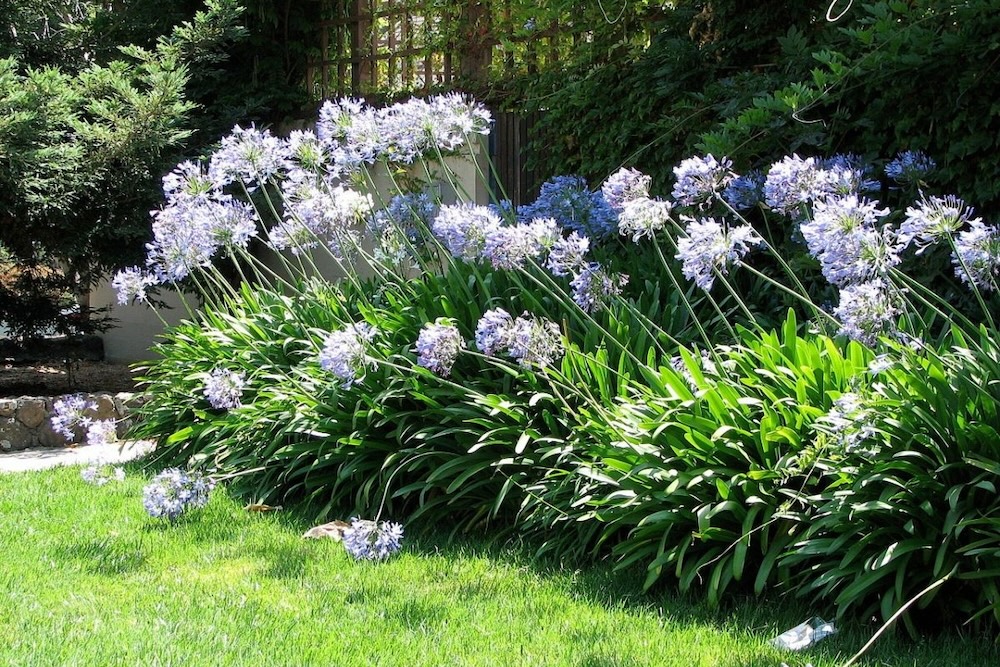Agapanthus Expanding Problems: Soil, Sunshine, and Watering
Agapanthus Expanding Problems: Soil, Sunshine, and Watering
Blog Article
Grasping the Art of Agapanthus Care: Essential Steps for Healthy And Balanced Growth and Vivid Blooms
In the world of horticulture, the cultivation of agapanthus stands as a fulfilling undertaking for those that seek to nurture these sophisticated flowering plants. With their striking blossoms and stylish foliage, agapanthus has actually caught the interest of garden enthusiasts worldwide. However, accomplishing optimal development and vibrant blooms calls for a nuanced technique that includes various crucial steps. From selecting the best range to mastering trimming techniques, the journey in the direction of growing prospering agapanthus plants is diverse and holds the vital to opening the complete possibility of these organic treasures.

Picking the Right Agapanthus Variety

When selecting the best Agapanthus selection for your garden, consider aspects such as environment suitability, flower shade, and growth habit. Agapanthus, typically called Lily of the Nile or African lily, comes in a range of shades ranging from shades of purple and blue to white. Pick a flower shade that matches your existing yard scheme to create a harmonious landscape. In addition, think about the climate in your region to ensure the Agapanthus variety you select can prosper in your specific problems. Some varieties are a lot more forgiving of chilly temperatures, while others prefer warmer climates. Understanding the growth habit of different Agapanthus ranges is crucial for correct placement within your yard. Some ranges have a clumping development behavior, suitable for boundaries or containers, while others have an even more spreading nature, ideal for ground cover or mass growings. By thoroughly evaluating these aspects, you can select the ideal Agapanthus selection to boost the beauty of your garden.
Suitable Planting Problems
Considering the optimal environmental requirements is necessary for effective Agapanthus growing. Agapanthus plants are delicate to cool temperature levels and ought to be protected from frost during winter months.
To make certain healthy and balanced development and lively blooms, plant Agapanthus light bulbs at a depth of about 2-4 inches and room them 8-12 inches apart. Mulching around the base of the plants aids keep dampness and subdues weed development.
Watering and Fertilizing Tips
Keeping correct wetness degrees and offering necessary nutrients are vital components in the treatment routine for Agapanthus plants. When it comes to watering Agapanthus, it is crucial to strike a balance. These plants favor constantly wet dirt yet are vulnerable to root rot if overwatered.
Feeding Agapanthus is essential for promoting healthy and balanced development and respected blooms. Use a well balanced fertilizer, such as a 10-10-10 formula, in the very early spring as brand-new development emerges. By following these watering and feeding suggestions, you can ensure your Agapanthus plants flourish and generate vivid, resilient blossoms.
Pruning Methods for Agapanthus
Trimming Agapanthus plants at the proper times and with appropriate strategies is critical for keeping their health and wellness and promoting optimal growth and flowering. The suitable time to prune Agapanthus is in late winter season or see here now very early spring before brand-new growth arises. Beginning by removing any kind of dead or yellowing fallen leaves near the base of the plant. Cut them as short as possible without damaging the arising shoots.
For flowered stems, wait until the blossoms have actually withered and afterwards cut them back to the base. This not just cleans up the plant's appearance however likewise encourages the growth of brand-new blossom buds. Deadheading spent flowers can additionally reroute the plant's power into creating even more blossoms instead of setting seeds. Nonetheless, if you wish to gather seeds for proliferation, leave some flowers to dry and mature on the plant.
Bear in mind to use clean, sharp tools to make specific cuts and decrease the risk of introducing illness. Agapanthus. Normal pruning will help maintain your Agapanthus looking cool and healthy while making certain a plentiful display screen of lovely blossoms
Handling Common Bugs and Conditions
After making sure proper trimming techniques for Agapanthus, it is necessary to address common bugs and illness that can affect the wellness and vitality of these plants. One typical parasite that affects Agapanthus is the Agapanthus linked here gall midget.
One more typical concern is fungal fallen leave area, which provides click for more as dark lesions on the fallen leaves. To prevent fungal illness, make certain excellent air flow around the plants, stay clear of above watering, and remove any kind of infected leaves quickly. In addition, Agapanthus plants can deal with origin rot if they are grown in improperly draining dirt. To prevent this, plant Agapanthus in well-draining soil and avoid overwatering. By being alert and taking punctual action versus conditions and pests, you can assist your Agapanthus plants prosper and create lively blossoms.

Conclusion
In final thought, mastering the art of agapanthus treatment involves selecting the ideal range, giving excellent growing problems, correct watering and fertilizing, ideal pruning methods, and resolving common parasites and diseases. By following these essential actions, you can guarantee healthy growth and vibrant blooms for your agapanthus plants. Remember to routinely keep an eye on and maintain your plants to promote their overall well-being and longevity.
To make sure healthy growth and dynamic flowers, plant Agapanthus bulbs at a deepness of concerning 2-4 inches and space them 8-12 inches apart. By complying with these watering and fertilizing ideas, you can ensure your Agapanthus plants grow and produce vivid, resilient blooms.
One typical insect that influences Agapanthus is the Agapanthus gall midget. Furthermore, Agapanthus plants can experience from root rot if they are planted in inadequately draining pipes soil. By following these crucial steps, you can guarantee healthy growth and lively blossoms for your agapanthus plants.
Report this page